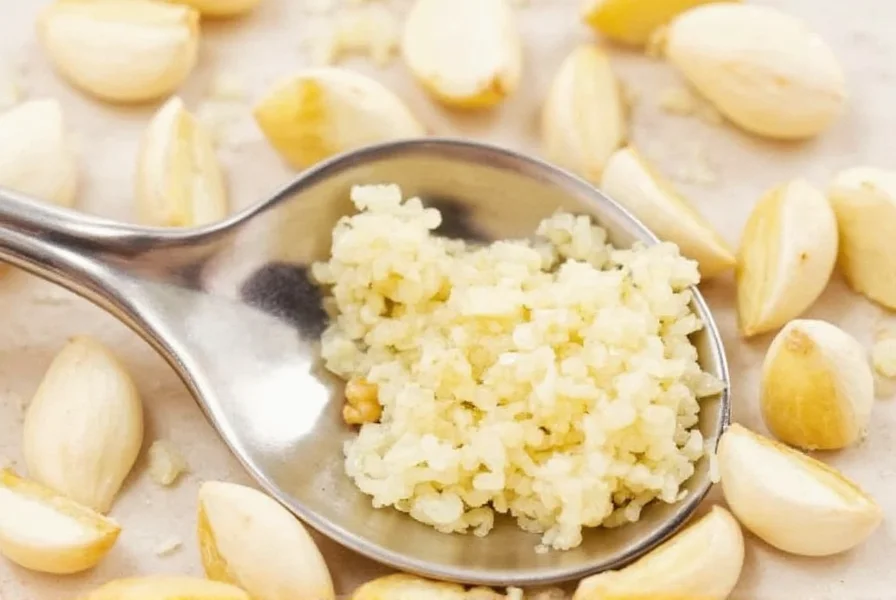Getting garlic measurements right can make or break your culinary creations. When recipes call for minced garlic but you're working with whole cloves, knowing the exact conversion is crucial for achieving balanced flavors. The standard measurement most culinary professionals use is that one medium-sized garlic clove yields about 1/2 teaspoon of minced garlic.
This conversion assumes proper mincing technique - the garlic should be finely chopped into uniform pieces without being mashed into a paste. The actual volume can vary based on several factors including clove size, freshness, and your mincing method.
Garlic Clove Size Matters
Not all garlic cloves are created equal. Grocery store garlic typically comes in three size categories that affect your measurements:
| Garlic Clove Size | Minced Garlic Equivalent | Raw Garlic Weight |
|---|---|---|
| Small (1/2" diameter) | 1/4 teaspoon | 3-4 grams |
| Medium (3/4" diameter) | 1/2 teaspoon | 6-8 grams |
| Large (1"+ diameter) | 1 teaspoon | 10-12 grams |
Factors Affecting Garlic Measurements
Several variables influence how much minced garlic you'll get from a single clove:
- Cultivar differences - Different garlic varieties have varying clove sizes
- Moisture content - Fresher garlic contains more water and may yield slightly more volume
- Mincing technique - How finely you chop affects packing density
- Packing method - Whether you lightly fill or firmly pack the measuring spoon
For the most accurate results in baking or delicate sauces where precision matters most, consider weighing your garlic. One medium clove typically weighs 6-8 grams before mincing.
Practical Kitchen Applications
Understanding garlic measurements becomes particularly important when scaling recipes up or down. Many home cooks make the mistake of thinking "a few cloves" is sufficient without considering that "a few" could mean anywhere from 1 to 3 teaspoons of minced garlic, dramatically altering the final dish.
When following recipes that specify "3 cloves minced," you can confidently measure out 1 1/2 teaspoons of freshly minced garlic. This knowledge proves especially valuable when you're working with pre-minced garlic from a jar, where the "clove equivalent" labeling can be inconsistent.
Substituting Jarred Minced Garlic
If you're using pre-minced garlic from a jar instead of fresh cloves, note that the flavor profile differs slightly due to preservatives and oxidation. As a general rule:
- 1 teaspoon jarred minced garlic ≈ 1.5 teaspoons fresh minced garlic in flavor intensity
- Reduce jarred garlic by 25-30% when substituting for fresh
- Add jarred garlic later in the cooking process to preserve flavor
For best results with jarred products, look for options packed in oil rather than vinegar-based solutions, as these maintain better flavor integrity.
Advanced Measurement Tips
Professional chefs often use these techniques for perfect garlic measurements:
- The water displacement method - Place minced garlic in a measuring spoon over water to see the exact volume
- Microplane grating - For ultra-fine garlic that measures more consistently
- Freezing technique - Freeze cloves briefly to make mincing easier and more precise
Remember that roasted garlic yields less volume than raw due to moisture loss during cooking. One roasted medium clove typically equals about 1/3 teaspoon of minced roasted garlic.
FAQ: Common Garlic Measurement Questions
How many tablespoons of minced garlic equals one clove?
One medium garlic clove equals approximately 1/6 tablespoon of minced garlic, since there are 3 teaspoons in a tablespoon and one clove equals about 1/2 teaspoon. For practical kitchen use, most cooks simply remember that 3 cloves of garlic equal roughly 1 tablespoon of minced garlic.
Does the age of garlic affect the minced measurement?
Yes, older garlic tends to dry out and lose moisture, which means you'll get slightly less volume when minced compared to fresh garlic. Aged garlic cloves may yield up to 20% less minced volume than fresh ones. For critical recipes, use garlic that's firm with tight skins for the most accurate measurements.
Can I use garlic powder as a substitute for minced garlic?
Yes, but the conversion differs significantly. As a general rule, 1/8 teaspoon of garlic powder equals one fresh garlic clove. Garlic powder is more concentrated, so you need much less. Remember that garlic powder provides a different flavor profile - it's more earthy and less pungent than fresh minced garlic.
How much minced garlic equals 2 cloves?
Two medium garlic cloves equal approximately 1 teaspoon of minced garlic. If you're working with small cloves, 2 might yield only 1/2 teaspoon, while 2 large cloves could produce up to 2 teaspoons. For recipe accuracy, especially in delicate dishes, consider weighing your garlic - two medium cloves typically weigh 12-16 grams before mincing.
Why does my minced garlic measurement seem inconsistent?
Inconsistent measurements usually come from variable mincing techniques or clove sizes. To achieve consistent results: use uniform mincing size, lightly fill (don't pack) measuring spoons, use cloves of similar size within a recipe, and consider weighing garlic for critical applications. Professional kitchens often standardize by weight rather than volume for this reason.











 浙公网安备
33010002000092号
浙公网安备
33010002000092号 浙B2-20120091-4
浙B2-20120091-4